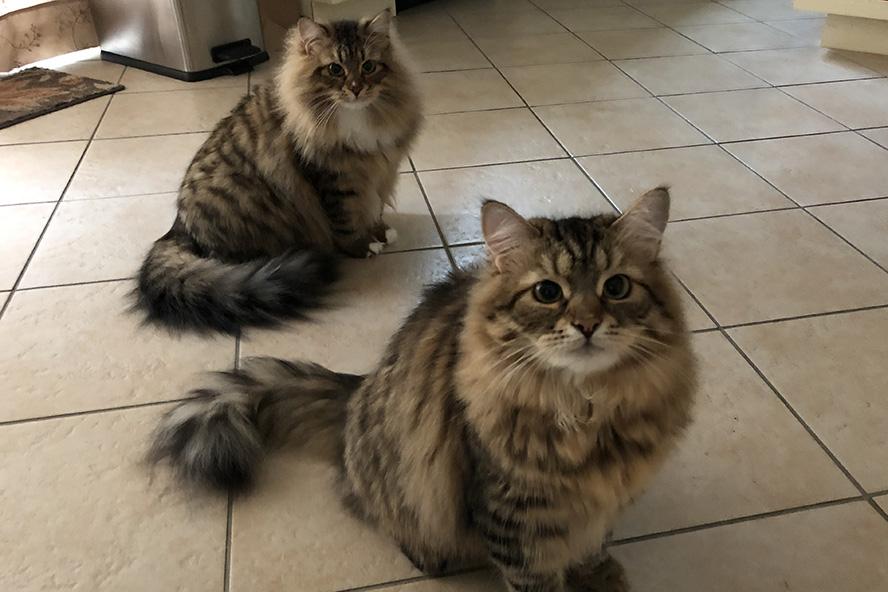-
About
- Leadership & Faculty
- News & Events
-
Academics
- Graduate
- Advanced Clinical Training
- Continuing Education
-
Student Life
-
-
Accommodations
- Our Campus
-
Accommodations
- Graduate Resources
-
-
Research
-
Hospitals & Clinics
- Emergency Care
- Hospital Services
-
Community Outreach
- Volunteer
A Cautionary Tale of Nutrition
Calcium-deficient kittens saved by switch to well-balanced diet

For information about balanced diets for pets, see our faculty nutritionists’ blog, Petfoodology.
“She was a very playful kitten until suddenly she was hiding and meowing in pain,” said Ruby Burke, owner of Serenity, a five-month-old purebred Siberian cat. “We didn’t know what was wrong and we had just gotten her and her litter mate, Lion, only two months prior.”
When Serenity was brought to the Emergency and Critical Care (ECC) unit of Cummings School of Veterinary Medicine’s Henry and Lois Foster Hospital for Small Animals in February, she was lethargic, in pain, and had a diminished appetite.
Bloodwork revealed hypocalcemia (low calcium), so Serenity was hospitalized overnight and further evaluated by Dr. Alexandra Allen, an ECC resident, the following morning.
Dr. Allen was surprised to find that Serenity’s bones were very thin on an x-ray. “They looked like cartilage,” says Allen. “The bone density was really poor.”
Serenity also had a pathological fracture of her right humerus (arm). “She had a fracture because her bones weren’t strong,” Allen explains.
Due to frail bone density, surgical repair of the fracture would have been challenging and could have resulted in additional fractures, so it was ruled out, and Serenity would not tolerate a splint of the bone, so the medical team redirected its attention.
A check on their dietary history revealed that Serenity and Lion were not receiving the calcium and other mineral supplements needed to balance the raw food diet they had been eating.
“It was very disappointing to find out that it was her diet that was the cause of her bone issues,” Burke laments. “We were following the advice of the breeder and thought we were doing the right thing.” Lion’s calcium level was not as low as Serenity’s and her bone density was not as severely affected, so she had not yet developed complications.
Allen cautions, “We found out that the information on the label of the kittens’ original diet read, in tiny type, that this is an incomplete diet and requires additional minerals and supplements.”
A miscommunication led to a dangerous health situation for the kittens. Deborah Linder, V09, VG16, a board-certified veterinary nutritionist and faculty member, Department of Clinical Sciences, assessed the kittens’ diet. “The lack of calcium in their diet did not allow their bones to grow,” Linder explains. “We recommended they change to a diet that met all their essential nutrients and has an AAFCO [Association of American Feed Control Officials] nutritional adequacy statement for growing kittens to address this deficiency. It’s so important for pet owners to ensure that their animals are eating a balanced diet so their bodies can develop properly.”
Allen adds, “Calcium is needed throughout the body, and is key for contraction of all muscles, as well as nerve signaling, blood clotting and hormone release. Serenity’s body started resorbing whatever calcium she had in her bones to be used elsewhere.”
Dr. Francisco Conrado, a clinical pathologist and assistant professor in the Department of Comparative Pathobiology, addressed the frequency of similar cases. “Certain species, such as reptiles, are more prone to this condition – secondary nutritional hyperparathyroidism – but we don’t see it often in other species. With a trend in home-prepared and other unconventional diets this could become an issue if the diet is not balanced with the proper nutrients each species needs to grow.”
Linder adds, “Generally, all pets need to be on a puppy/kitten diet that meets AAFCO growth requirements for their first year of life. Large breed dogs may take a little longer.”
Fortunately for Serenity and Lion, the switch to a balanced kitten diet produced the desired results. “It controlled their calcium better and Serenity received periodic calcium gluconate IV in addition to her feedings, based on rechecked bloodwork,” Allen says. Serenity’s calcium levels returned to normal after three days of treatment at Foster Hospital and she was sent home with a strict activity restriction to allow her fractured arm to heal on its own.
Follow-up visits revealed normal calcium and hormonal levels in both kittens, and a follow-up x-ray in March showed that Serenity’s humerus healed well, but at a slightly abnormal angle.
“Serenity is doing well now, and we are happy about the treatment she received,” says Burke. “Dr. Allen and the veterinary team were so caring of our pets, and we greatly appreciate it.”
Department:
Foster Hospital for Small Animals